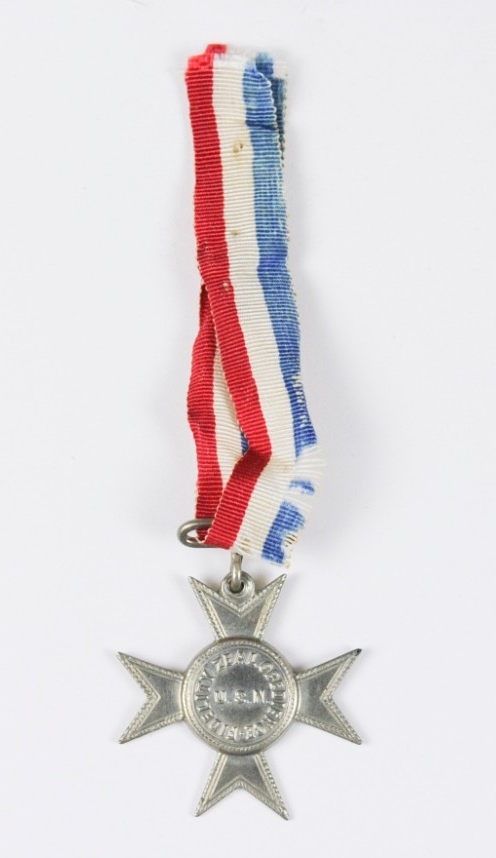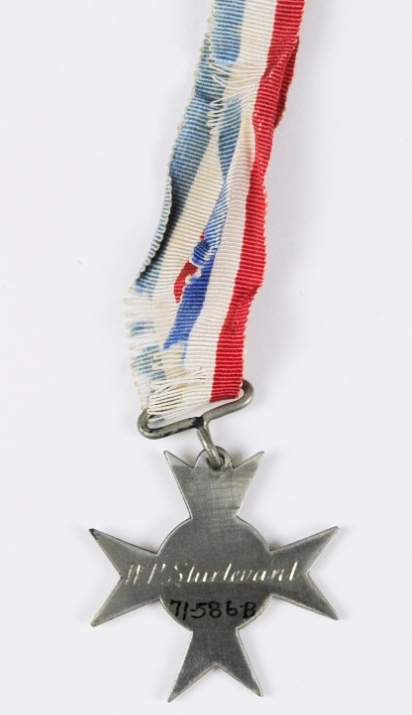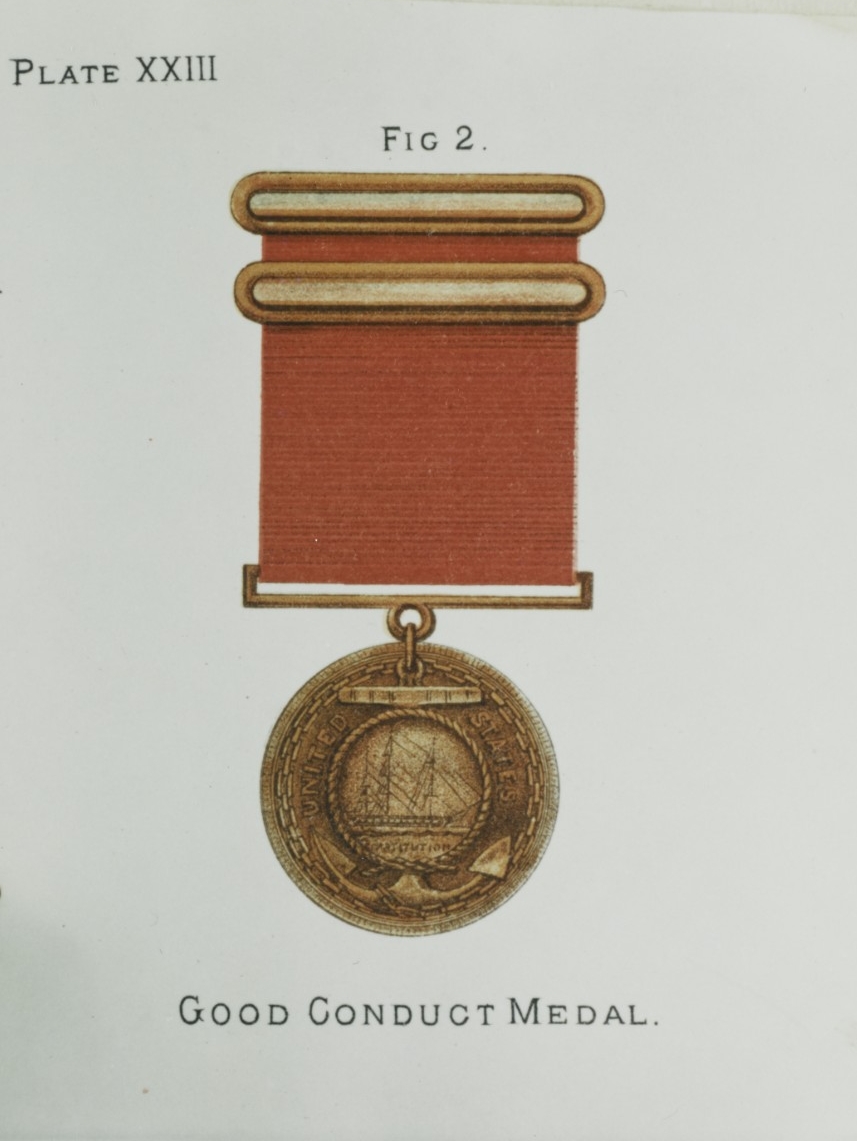The Navy Good Conduct Medal
The Navy’s first Good Conduct Medal—called the Good Conduct Badge—looked nothing like today’s. First authorized on 26 April 1869, for “obedience, sobriety, and cleanliness” as well as proficiency in “gunnery and seamanship,” the decoration came in the shape of a Maltese cross of nickel, the center of which was rounded out by a medallion.1 In the 1880s, the Navy had the medal redesigned in the form of a bronze planchet that has stayed more or less the same for the last 135 years.2 But whereas the medal itself changed little after 1884, the criteria for receiving it shifted in response to a process of modernization underway since the end of the nineteenth century.
Manning the Postbellum Navy
The Good Conduct Medal reflects the later 19th-century approach to Navy enlistment, quite different from today’s. In the post–Civil-War period, when a man enlisted, his enlistment entailed a single cruise on a single ship. Returning to port for an extended period meant discharging all of the enlisted men, some of whom—on recommendation of the commanding officer—might be eligible to reenlist for a cruise at a later date.
Bereft of their crew upon return to port, Navy commanding officers, who were often responsible for recruiting their own Sailors, now had to scramble to find trained seamen willing to forgo opportunities offered by the merchant marine, which often promised better pay, better living conditions, and better treatment.3 Although the Panic of 1873 and the subsequent “Great Depression” of the 1870s to the 1880s helped reduce labor-market competition, better opportunities on civilian vessels persisted.4 For the Navy, then, quality sailors were hard to come by. Alcoholism, criminality, insubordination, and desertion were rampant.5 It is likely that in the two decades after the Civil War, a full one-eighth of the U.S. Navy personnel deserted every year.6 What could officers do to retain talent and improve the pool? The Good Conduct decoration was among the solutions.
Before the Good Conduct Badge, the Navy’s only medal had been the Medal of Honor, a product of the Civil War. That decoration had been in recognition of extraordinary heroism, which made sense in a time of mass mobilization. But after the war, with the peacetime return to a professional force of sailing ships, the Navy now placed a premium on seamen trained to do a job day in, day out.7 The Good Conduct Badge was supposed to help incentivize reenlistment of already trained Sailors and, as such, it passed only to men after their second period of service.8
The Good Conduct Badge (Medal after 1896) was one in a series of attempts since before the Civil War to ease the shortage of trained seamen willing to re-enlist in the Navy.9 By 1855, a Sailor could expect a modest raise and what amounted to a paid vacation—up to four months’ free wages—between enlistments.10 Then in 1865 the Navy authorized the Honorable Discharge Badge, a 2.5-inch patch in the shape of a foul anchor, to be sewn onto the sleeve and appended with a half-inch star for every additional honorable discharge over the course of a career.11 This practice helped distinguish the strong from the weak and might have instilled pride in good conduct at sea. At any rate, desirable enlistees, already trained by a cruise at sea with the Navy, could now be easily identified. Finally, to encourage reenlistment, the Secretary of the Navy authorized the first Good Conduct decoration, the Maltese-cross-shaped medal for “fidelity, zeal, [and] obedience,” provided the Sailor had re-enlisted and completed his second cruise.12
More meaningful than the medal, however, would have been the monetary reward that came in conjunction with reenlistment. To claim it, a Sailor had to show his Good Conduct Badge and honorable discharge papers. (Twenty years of good conduct, moreover, got him a pension in some cases and, in other cases, admission to a naval hospital or home.) The Good Conduct Badge, the modest pay raise, and the paid vacation, all of which continuous-service men could enjoy after 1869, became the trifecta of incentives that the Bureau of the Navy offered its most accomplished enlisted men.13
Turn-of-the-Century Reforms
The Navy’s approach to recruitment and retention took a more systematic approach only at the end of the 19th century.14 By the 1890s, U.S. foreign policy had begun to gravitate toward imperialism, and imperialism required above all a competitive fleet of steam-powered ships.15 In face of the need for thousands more Sailors to man a steel armada of ocean-going vessels, the Navy’s recruitment and retention practices had to change.16 By extension, the criteria for awarding the Good Conduct Medal would also need adjustment.
The Spanish-American War in 1898 transformed the Navy’s fitful, uneven process of modernization into a robust and overarching one.17 In the midst of the conflict, a Congressional committee’s report of May 1898 recommended sweeping changes, including the institution of fixed-term enlistments as a way to provide continuity of personnel for these most modern, complex, steam-powered ships of the line.18 The changes became law with the Naval Personnel Act of 1899.19
A few years later, in the spirit of incentivizing good conduct and reenlistment, the Navy further increased annual pay for holders of a Good Conduct Medal.20 The bonus continued to increase, as did standard pay for enlisted men—another incentive to staying with the Navy.21
As the twentieth century progressed, the criteria for receiving the Good Conduct Medal ultimately landed on a path of steady democratization: The requirements of a past honorable discharge and reenlistment within three months fell away, and other criteria began to take their place.22
The New Navy
In the 20th century, the Good Conduct Medal’s criteria came to prioritize proficiency in rating.23 (New ratings proliferated with the transition to steam power.) By 1914, marks in rating—on the scale of 1 to 5—were part of the equation. To earn the Good Conduct Medal, a junior Sailor needed a minimum average of 4 in his area of proficiency, while a petty officer needed 4.5. (Both required 4.5s in sobriety and obedience.24) Soon after, the threshold came down to threes and eventually twos, ensuring that the majority of reenlisting Sailors would receive the Good Conduct Medal almost as a matter of course after World War I.25 And after the next World War, a well-behaved, hardworking Sailor could expect to receive the Good Conduct Medal in his first period of enlistment and after a single term of three years.26 His or her counterpart of the 1890s would have needed an honorable discharge, a reenlistment, and eight years of service before seeing the same medal.27
There were now better ways than a medal to retain skilled labor, and these had to do not only with compensation and benefits, which had steadily increased since the nineteenth century, but also with the Navy’s 20th-century commitment to training its recruits and with the cultural shift in how people saw Navy service—as a career, not a last resort, as had often been the case in the 19th century.
Finally, the transformation of life aboard ships did more than any medal could do to make the Sailor’s life more attractive. As historian Frederick Harrod observes, the great vessels of the new Navy were now spacious and advanced enough for unprecedented amenities: bunks (instead of hammocks), clean water, plumbing, barbershops, libraries, recreation rooms, laundries, electric lighting, forced-air ventilation, dishwashing machines, and refrigeration. As early as 1906, the Maine-class battleship Missouri (Battleship No. 11) even had her own electric ice-cream maker.28 Sea service to the United States was no longer the existential trial it must have been in the nineteenth century.
The Navy of 1869—the Navy that had established the Good Conduct Badge—faced issues of morale, discipline, and safety that the modern Navy does not know. In our age, the Good Conduct Medal serves a different purpose: It is a rite of passage and an honor, to be sure, but its historical role as part of a reenlistment strategy has gone the way of canvas topsails and gilded figureheads.
—Adam Bisno, Ph.D., NHHC Communication and Outreach Division, April 2019
_____________
1 David Borthick and Jack Britton, Medals, Military and Civilian, of the United States (Tulsa, OK: MCN, 1984), 208.
2 John E. Strandberg and Roger James Bender, The Call of Duty: Military Awards and Decorations of the United States of America (San Francisco: R. James Bender, 1994), 134.
3 Frederick S. Harrod, Manning the New Navy: The Development of a Modern Naval Enlisted Force, 1899–1940 (Westport, CT: Greenwood, 1978), 8; James F. Downs, Judith Cohart, and Constance Ojile, Naval Perseonnel Organization: A Cultural-Historical Approach, Development Research Associates report (Arlington, VA, 1982), 9, available here.
4 American experienced this first “Great Depression” as a long of job shortages and declining real wages, punctuated by short-lived recoveries, into the 1890s. See Foner, 512–522; Eric Hobsbawm, The Age of Capital, 1848–1875 (London: Weidenfeld & Nicholson, 1975), 4–5, and The Age of Empire, 1875–1914 (New York: Vintage, 1989), 50–51; Joseph Davis, “An Improved Annual Chronology of U.S. Business Cycles Since the 1790s,” Journal of Economic History 66 (2006), 103–21.
5 Peter Karsten, The Naval Aristocracy: The Golden Age of Annapolis and the emergence of Modern American Navalism (New York: Free Press, 1972), 77; Harrod, Manning the New Navy, 11–13.
6 Harrod, Manning the New Navy, 13.
7 Allan R. Millett and Peter Maslowski, For the Common Defense: A Military History of the United States of America, revised edition (New York: Free Press, 1994), 251.
8 Downs, Naval Personnel, 9.
9 Borthick and Britton, Medals, 207.
10 James F. Downs, Judith Cohart, and Constance Ojile, Naval Personnel Organization: A Cultural-Historical Approach, Development Research Associates report (Arlington, VA, 1982), 9, available at https://apps.dtic.mil/docs/citations/ADA119778. Four months eventually became three months, according to a June 1880 direction from Commodore Earl English, Chief of the Bureau of Navigation, but it is unclear how or to what extent the Navy enforced these policies. See Earl English, “Qualifications for Navy Good Conduct Badge,” Washington, DC, 1 June 1880; U.S. Navy Department Library; Microfiche, CIS U.S. Executive Branch Documents, 1789–1909, no. N504–11.4.
11 U.S. Bureau of Naval Personnel, Decorations, Medals, Ribbons, and Badges of the United States Navy, Marine Corps, and Coast Guard, 1861–1948 (Washington, DC: U.S. Government Printing Office, 1951), 23.
12 Borthick and Britton, Medals. 207–8.
13 Ibid., 207.
14 Karsten, Naval Aristocracy, 77; Downs, Naval Personnel, 9.
15 Millett, Common Defense, 250 and 268.
16 Harrod, Manning the New Navy, 34.
17 Millett, Common Defense, 249–51; Downs, Naval Personnel, 7.
18 George E. Foss and the Committee on Naval Affairs, Personnel of the Navy, Report No. 1375; submitted to the House of Representatives to accompany H.R. 10403; 55th Congress, 2nd Session (Washington, DC: Government Printing Office, 1898). In fact, fixed-term enlistments were already available in many ratings. The 1899 legislation affirmed fixed-term enlistments as the Navy’s new standard.
19 This legislation also gave engineers a place in the officer corps and reformed the entire systems of recruiting, enlistment, training, and retirement.
20 Harrod, Manning the New Navy, 70.
21 U.S. Bureau of Naval Personnel, Decorations (1951, op. cit.), 23; United States Navy, The Bluejackets’ Manual (Washington, DC: Government Printing Office, 1916), 69.
22 Department of the Navy, Navy and Marine Corps Awards Manual, NAVPERS 15,790 (Rev. 1953), 29, available at the Navy Department Library.
23 Harrod, Manning the New Navy, 5.
24 United States Navy, The Bluejackets’ Manual (Washington, DC: Government Printing Office, 1914), 55.
25 U.S. Bureau of Naval Personnel, Decorations (1951, op. cit.), 24; Department of the Navy, Navy and Marine Corps Awards Manual, NAVPERS 15,790 (Rev. 1953), 29, available at the Navy Department Library.; ALNAV 025/14: Changes to Navy Good Conduct Medal, CNO Washington DC, accessed 2 April 2019.
26 United States Navy, The Bluejackets’ Manual (Washington, DC: Government Printing Office, 1946), 143.
27 U.S. Bureau of Naval Personnel, Decorations (1951, op. cit.), 24; Department of the Navy, Bureau of Navigation, Bureau of Navigation Manual (Washington: Government Printing Office, 1925), 30h.
28 Harrod, Manning the New Navy, 148.





